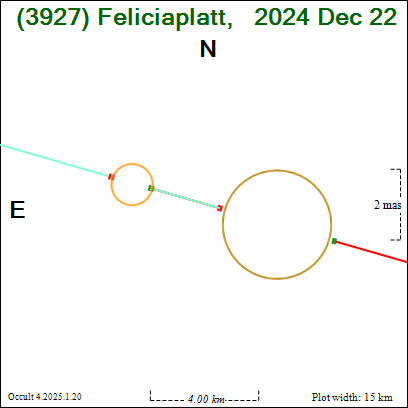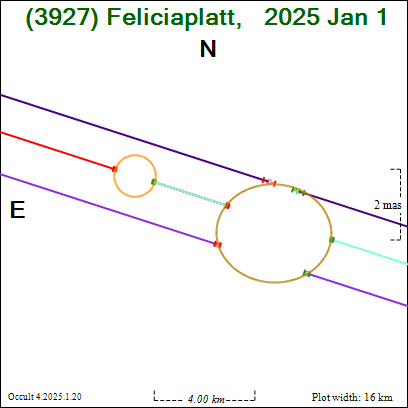Kai Getrost > CBETs > CBET 5511
This is an HTML version of the text-only
CBET 5511 .
See Wikipedia
and CBAT's history for more background.
Electronic Telegram No. 5511
Central Bureau for Astronomical TelegramsURL (3927) FELICIAPLATT
D. Herald, Murrumbateman, Australia writes on behalf of the
International Occultation Timing Association (IOTA) that
V. Sempronio, observing near Benson, AZ, USA; K. Getrost,
observing near Fort Gaines, GA, USA; and R. Venable, observing
near Yemassee, SC, USA, report the discovery of a satellite of
minor planet (3927) from two separate occultation observations
made 10 days apart.
On 2024 Dec. 22.1119 UT, Sempronio observed (3927) occult the star
UCAC4 494-001568 and measured two clear consecutive occultations
with durations of 0.184 and 0.530 s, with an interval of 0.318 s,
resulting in chord lengths of 1.5 and 4.0 km with a mid-chord
separation of 2.8 km:
Light curve for 2024 Dec. 22.1119 UT V. Sempronio observation.
Flux is given in analog-to-digital units, or ADU, which is set to
zero for the limiting magnitude of the recording).
Both occultation drops were more than 1.6 magnitudes, clearly
excluding a double-star hypothesis.
On 2025 Jan. 1.0431, Getrost and Venable observed (3927) occult
the star UCAC4 497-001699. Getrost measured two clear consecutive
occultations of duration 0.134 and 0.357 s with an interval of
0.251 s:
Venable operated two stations (one unattended) and measured two
occultations by the main body only of 0.100 s:
and 0.305 s:
An ellipse of 4.57 km x 3.90 km was fitted to the three chords
across the main body, and a chord length of 1.65 km for the
satellite with a mid-chord separation of 3.0 km. The position of
the satellite relative to the main body for both occultation
observations are: 0".0043 in p.a. 74.0 degrees on 2024
Dec. 22.1119, and 0".0042 in p.a. 67.6 degrees on 2025
Jan. 1.0431.
The sky-plane plot for the Dec. 22 event:
shows the star moving from left to right, with red markers on the
chords for disappearance and green markers denoting reappearance,
and the length of those markers indicating the uncertainty in the
time of that event; the scale of the plot is given in both km (at
the asteroid) and in milliarcseconds (as viewed from the earth),
while the size of the main body is set to the NEOWISE diameter and
that of the satellite is set to a circle with a diameter matching
the chord length. The horizontal scale of the corresponding light
curve of Sempronio gives the offset in seconds from the specified
UTC hour + minute.
The sky-plane plot of the Jan. 1 event:
depicts the light curves of Venable (top chord; shorter
occultation), Getrost (middle chord), and Venable (unattended
station; bottom chord), in which the primary component has an
elliptical profile fitted to match the occultation events in the
three chords, with formal uncertainties in the axes of that
ellipse being about 100 meters; the size of the satellite is set
to a circle with a diameter matching the chord length. The "miss"
chords on either side exclude the satellite from being of
significantly larger diameter.
D. Gault, Trans-Tasman Occultation Alliance (TTOA), and D. Herald
(IOTA and TTOA) aided in the analysis of these observations.
NOTE: These 'Central Bureau Electronic Telegrams' are sometimes
superseded by text appearing later in the printed IAU Circulars.
© Copyright 2025 CBAT CBET 5511 ) Daniel W. E. Green






